The Wheel Aligner Equipment Market is estimated to be valued at USD 1.3 billion in 2025 and is projected to reach USD 1.9 billion by 2035, registering a compound annual growth rate (CAGR) of 4.0% over the forecast period. The wheel aligner equipment market is projected to generate an absolute dollar opportunity of USD 600 million over the forecast period. This growth is supported by a steady CAGR of 4%, driven by the increasing need for precise wheel alignment systems in the automotive industry, especially with the rise in vehicle production and demand for efficient vehicle servicing. In the first five-year phase (2025–2030), the market is expected to grow from USD 1.3 billion to USD 1.6 billion, adding USD 300 million, which accounts for 50% of the total incremental growth.
The second phase (2030–2035) will contribute USD 300 million, representing 50% of the total growth, as demand for advanced, automated, and eco-friendly wheel aligner systems continues to rise, particularly in emerging markets. Annual increments will rise from USD 60 million in the early years to USD 80 million by 2035, reflecting accelerated growth driven by technological advancements, higher vehicle fleet volumes, and increasing demand for tire maintenance solutions. Manufacturers focusing on innovation, automation, and sustainability will capture the largest share of this USD 600 million opportunity.

| Metric | Value |
|---|---|
| Wheel Aligner Equipment Market Estimated Value in (2025 E) | USD 1.3 billion |
| Wheel Aligner Equipment Market Forecast Value in (2035 F) | USD 1.9 billion |
| Forecast CAGR (2025 to 2035) | 4.0% |
The wheel aligner equipment market is witnessing steady growth due to increasing vehicle parc, heightened focus on road safety, and the proliferation of service centers offering advanced diagnostic services. Growing awareness around vehicle maintenance and the impact of misaligned wheels on fuel efficiency, tire wear, and handling performance has driven adoption across both independent and franchise workshops.
Integration of automated calibration systems, 3D imaging, and digital interfaces is enhancing service precision and turnaround time. Stringent safety regulations and vehicle inspection mandates in several regions are further accelerating the deployment of alignment systems.
The long term outlook is positive as technological evolution and fleet expansion continue to influence periodic maintenance practices, making wheel alignment a vital service component in the automotive aftermarket.
The wheel aligner equipment market is segmented by product type, mobility, end users, technology, vehicle, distribution channel, and geographic regions. By product type, the wheel aligner equipment market is divided into Imaging Wheel Aligners, Conventional Wheel Aligners, and Truck Wheel Aligners. In terms of mobility, the wheel aligner equipment market is classified into fixed and portable. Based on end users, the wheel aligner equipment market is segmented into Garages, Auto OEMs, and Others. By technology, the wheel aligner equipment market is segmented into 3D Wheel Aligners, Laser-based Wheel Aligners, Infrared Wheel Aligners, and Others. By vehicle, the wheel aligner equipment market is segmented into Passenger Cars and Commercial Vehicles. By distribution channel, the wheel aligner equipment market is segmented into OEMs and the Aftermarket. Regionally, the wheel aligner equipment industry is classified into North America, Latin America, Western Europe, Eastern Europe, Balkan & Baltic Countries, Russia & Belarus, Central Asia, East Asia, South Asia & Pacific, and the Middle East & Africa.
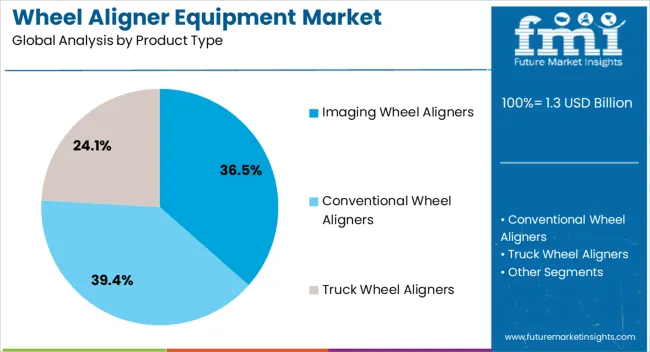
The imaging wheel aligners segment is projected to account for 36.50% of total market revenue by 2025, making it the dominant product type. This is primarily driven by its advanced measurement capabilities, superior accuracy, and faster diagnostic turnaround compared to conventional systems.
Imaging systems utilize high resolution cameras and integrated sensors to capture real time alignment parameters, reducing human error and enhancing operational efficiency. Workshops are increasingly opting for these systems due to their ability to handle a wide range of vehicle types and deliver consistent results.
Their compatibility with digital workflows and minimal calibration requirements has further reinforced their position in modern service environments, solidifying their leadership in the product type segment.
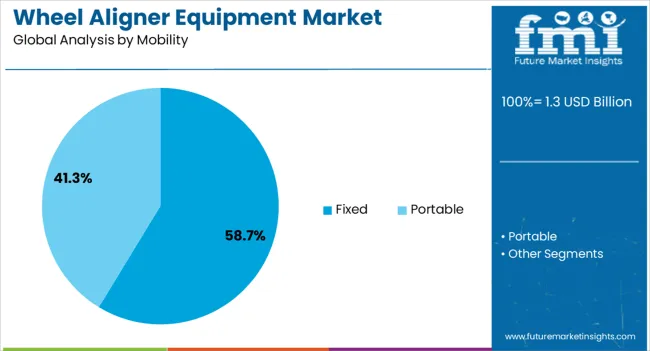
The fixed segment is expected to contribute 58.70% of market revenue by 2025 within the mobility category, establishing it as the leading segment. This dominance stems from the stability, precision, and long term usability offered by fixed alignment systems.
Service providers and garages prefer fixed setups for their durability, advanced imaging integration, and minimal repositioning needs during operations. These systems are particularly suited for high volume service centers where consistency and throughput are critical.
As workshop infrastructure modernizes and demand for comprehensive diagnostics rises, fixed wheel aligner systems are increasingly becoming the preferred choice, securing their leading position in the market.
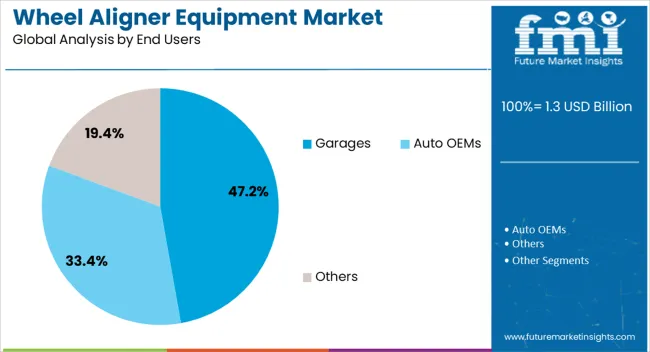
Garages are projected to represent 47.20% of the overall market revenue by 2025 under the end users category, positioning them as the largest segment. This growth is attributed to the increasing number of independent service providers and their rising investment in advanced diagnostic tools to stay competitive.
Garages serve a diverse customer base and prioritize fast, accurate, and cost-effective services. The demand for wheel alignment services has increased as vehicle owners prioritize preventive maintenance and optimal performance.
Furthermore, the availability of mid-range alignment systems tailored to garage-scale operations has accelerated adoption. The strategic importance of service diversification and customer retention has established garages as the leading contributors to the wheel aligner equipment market.
The wheel aligner equipment market is driven by increasing demand for automotive maintenance services and opportunities from expanding repair centers. Emerging trends like digital and automated wheel alignment systems are reshaping the market, while challenges related to high costs and complex installations remain. By 2025, overcoming these obstacles through cost-effective solutions and simplified installation processes will be crucial to ensuring continued market growth and making wheel aligners more accessible to automotive repair businesses worldwide.
The wheel aligner equipment market is experiencing growth driven by the increasing demand for automotive maintenance services. With the rise in vehicle ownership, especially in emerging markets, regular maintenance, including wheel alignment, has become essential for vehicle performance and safety. Wheel aligners are crucial in ensuring optimal tire life, fuel efficiency, and smooth handling. By 2025, the demand for wheel aligner equipment will continue to grow as the automotive industry increasingly focuses on vehicle maintenance and efficiency, particularly in commercial and passenger vehicles.
Opportunities in the wheel aligner equipment market are increasing with the growth of automotive repair and service centers. As the automotive industry continues to expand, the number of service centers offering maintenance and repair services is also growing. These service centers require high-quality, efficient wheel alignment equipment to meet the needs of consumers. By 2025, the demand for advanced wheel aligner systems in these centers will drive market growth, as more businesses invest in state-of-the-art equipment to enhance service efficiency and customer satisfaction.
Emerging trends in the wheel aligner equipment market include the development and adoption of digital and automated wheel alignment solutions. Traditional wheel aligners, while effective, are being gradually replaced by digital models that provide more precise measurements and faster results. Automated systems that require less manual intervention are also gaining traction due to their ability to increase accuracy and reduce human error. By 2025, these trends will dominate the market, offering more efficient and user-friendly solutions to automotive repair businesses and end consumers.
Despite growth, the wheel aligner equipment market faces challenges such as high equipment costs and complex installation processes. The cost of advanced wheel aligners can be prohibitively high, particularly for smaller repair shops and service centers in developing regions. Furthermore, the installation and calibration of these systems can be complex, requiring skilled technicians and additional training. By 2025, addressing these challenges through more affordable equipment options and simplified installation processes will be essential for making wheel aligners more accessible to a broader market.
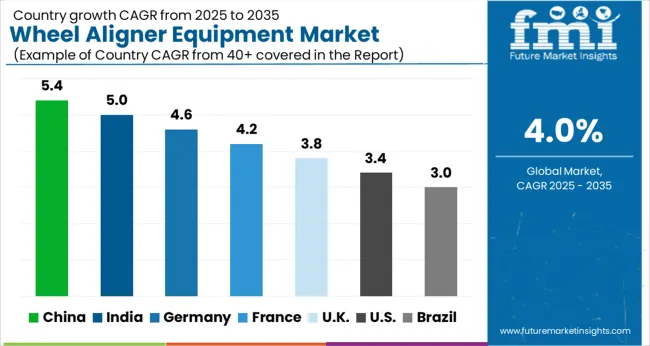
| Countries | CAGR |
|---|---|
| China | 5.4% |
| India | 5.0% |
| Germany | 4.6% |
| France | 4.2% |
| UK | 3.8% |
| USA | 3.4% |
| Brazil | 3.0% |
The global wheel aligner equipment market is projected to grow at a 4% CAGR from 2025 to 2035. China leads with a growth rate of 5.4%, followed by India at 5%, and Germany at 4.6%. The United Kingdom records a growth rate of 3.8%, while the United States shows the slowest growth at 3.4%. These varying growth rates are driven by increasing demand for vehicle maintenance, rising vehicle production, and technological advancements in alignment solutions. Emerging markets like China and India are experiencing higher growth due to increasing automotive manufacturing, infrastructure development, and rising demand for vehicle servicing. More mature markets like the USA and the UK see steady growth driven by the adoption of advanced alignment systems, regulatory standards for vehicle safety, and the increasing need for efficient vehicle maintenance solutions. This report includes insights on 40+ countries; the top markets are shown here for reference.
The wheel aligner equipment market in China is growing rapidly, with a projected CAGR of 5.4%. China’s booming automotive industry, coupled with a growing demand for vehicle maintenance and repair services, is driving the market for wheel aligners. The country’s increasing vehicle production, rising disposable incomes, and expanding middle class further contribute to market growth. Additionally, the growing focus on vehicle safety, along with increasing investments in vehicle servicing infrastructure, accelerates the demand for advanced wheel alignment systems. China’s government policies promoting automotive safety and environmental standards also drive the adoption of efficient and high-precision wheel aligner equipment.
The wheel aligner equipment market in India is projected to grow at a CAGR of 5%. India’s rapidly expanding automotive sector, coupled with the increasing demand for vehicle servicing solutions, continues to fuel the market for wheel aligners. The country’s growing focus on vehicle safety, rising vehicle ownership, and increasing vehicle manufacturing are key drivers of demand for wheel aligner equipment. Additionally, India’s expanding infrastructure, coupled with the government’s push for vehicle emission standards and safety regulations, further contributes to market growth. The rising number of service centers and the increasing adoption of advanced vehicle alignment systems are expected to drive the market.
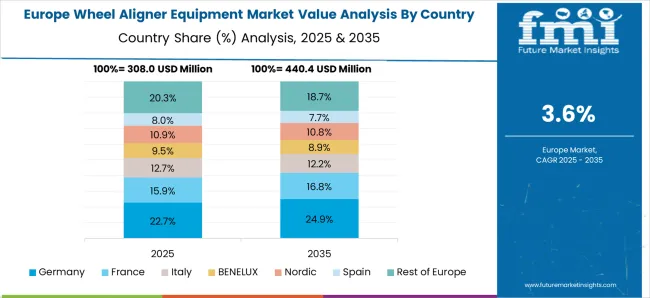
The wheel aligner equipment market in Germany is projected to grow at a CAGR of 4.6%. Germany’s demand for wheel aligner equipment is driven by the country’s strong automotive industry, which requires efficient vehicle maintenance and alignment solutions. The growing demand for precision in vehicle alignment, combined with the country’s commitment to vehicle safety and environmental regulations, is contributing to the market growth. Additionally, Germany’s focus on automotive innovation, including electric vehicle production, further accelerates the demand for advanced wheel aligners. Investments in modern vehicle servicing infrastructure and the increasing importance of vehicle safety standards continue to drive the adoption of wheel aligners in the country.
The wheel aligner equipment market in the United Kingdom is projected to grow at a CAGR of 3.8%. The UK’s demand for wheel aligner equipment is driven by increasing vehicle ownership, growing vehicle repair and maintenance needs, and a focus on vehicle safety. The country’s stringent safety and environmental standards continue to contribute to the adoption of advanced wheel aligners in vehicle service centers. Additionally, the growing adoption of electric vehicles and the demand for precision in automotive servicing further support market growth. The UK automotive sector’s shift towards automation and high-tech solutions in vehicle repair is expected to fuel the demand for advanced wheel aligner equipment.
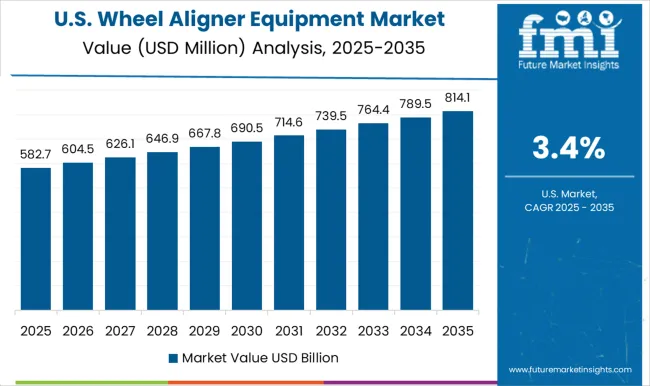
The wheel aligner equipment market in the United States is expected to grow at a CAGR of 3.4%. The USA market is driven by the increasing demand for reliable and efficient vehicle servicing solutions, particularly in the automotive repair sector. The country’s rising vehicle ownership and growing focus on vehicle safety contribute to the adoption of wheel aligners. Additionally, the USA automotive industry’s push for innovation, along with the growing importance of vehicle alignment in ensuring optimal vehicle performance and safety, further supports market growth. The increasing demand for electric vehicles and the adoption of advanced vehicle technologies also contribute to the growth of the wheel aligner market.
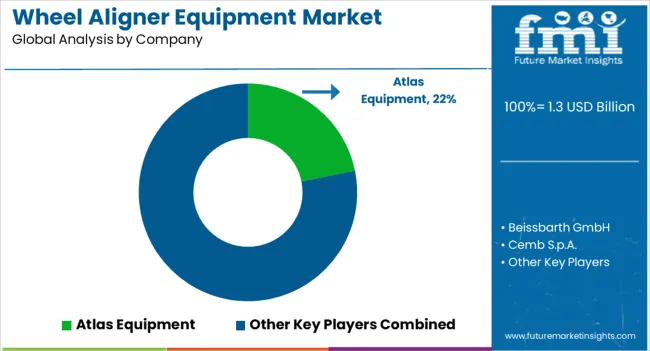
The wheel aligner equipment market is dominated by Hunter Engineering Company, which leads with its innovative and high-precision wheel alignment solutions used in automotive service centers and repair shops. Hunter’s dominance is supported by its cutting-edge technology, accuracy in alignment measurements, and strong customer base in the global automotive service industry. Key players such as Snap-on Incorporated, Atlas Equipment, and Beissbarth GmbH maintain significant market shares by offering reliable, easy-to-use wheel aligners that improve vehicle maintenance efficiency, reduce downtime, and enhance service quality. These companies focus on providing advanced features like digital measurements, integration with vehicle diagnostics, and user-friendly interfaces to meet the growing demand for precise and fast wheel alignment. Emerging players like Fori Automation, RAVAmerica, and Corghi S.p.A. are expanding their market presence by offering specialized wheel aligner equipment tailored for niche applications such as heavy-duty vehicles, electric cars, and high-performance sports cars. Their strategies include focusing on providing customized solutions, improving alignment accuracy, and integrating innovative technologies like automated calibration and real-time data monitoring. Market growth is driven by the increasing number of vehicles on the road, the rise of electric vehicles, and the growing demand for efficient, high-accuracy automotive service equipment. Innovations in alignment software, mobile solutions, and multi-functional tools are expected to continue shaping competitive dynamics and fuel further growth in the global wheel aligner equipment market.
| Item | Value |
|---|---|
| Quantitative Units | USD 1.3 Billion |
| Product Type | Imaging Wheel Aligners, Conventional Wheel Aligners, and Truck Wheel Aligners |
| Mobility | Fixed and Portable |
| End Users | Garages, Auto OEMs, and Others |
| Technology - 3D | Garages, Auto OEMs, and Others |
| Technology | 3D Wheel Aligners, Laser-based Wheel Aligners, Infrared Wheel Aligners, and Others |
| Vehicle | Passenger Cars and Commercial Vehicles |
| Distribution Channel | OEMs and Aftermarket |
| Regions Covered | North America, Europe, Asia-Pacific, Latin America, Middle East & Africa |
| Country Covered | United States, Canada, Germany, France, United Kingdom, China, Japan, India, Brazil, South Africa |
| Key Companies Profiled | Atlas Equipment, Beissbarth GmbH, Cemb S.p.A., Corghi S.p.A., Fori Automation, Hawkeye Systems, Inc., Hunter Engineering Company, RAVAmerica, Snap-on Incorporated, and Supertracker |
| Additional Attributes | Dollar sales by equipment type and application, demand dynamics across passenger vehicles, commercial vehicles, and electric vehicles, regional trends in wheel aligner adoption, innovation in 3D imaging and wireless technologies, impact of regulatory standards on precision and safety, and emerging use cases in autonomous vehicle calibration and smart workshop integration. |
The global wheel aligner equipment market is estimated to be valued at USD 1.3 billion in 2025.
The market size for the wheel aligner equipment market is projected to reach USD 1.9 billion by 2035.
The wheel aligner equipment market is expected to grow at a 4.0% CAGR between 2025 and 2035.
The key product types in wheel aligner equipment market are imaging wheel aligners, conventional wheel aligners and truck wheel aligners.
In terms of mobility, fixed segment to command 58.7% share in the wheel aligner equipment market in 2025.






Full Research Suite comprises of:
Market outlook & trends analysis
Interviews & case studies
Strategic recommendations
Vendor profiles & capabilities analysis
5-year forecasts
8 regions and 60+ country-level data splits
Market segment data splits
12 months of continuous data updates
DELIVERED AS:
PDF EXCEL ONLINE
Wheeled Bins Market Size and Share Forecast Outlook 2025 to 2035
Wheel Loader Scales Market Size and Share Forecast Outlook 2025 to 2035
Wheel Excavator Market Size and Share Forecast Outlook 2025 to 2035
Wheel Loader Market Size and Share Forecast Outlook 2025 to 2035
Wheel Balancing Market Size and Share Forecast Outlook 2025 to 2035
Wheel Tractor Scrapers Market Size and Share Forecast Outlook 2025 to 2035
Wheeled Insulated Cooler Market Trends - Growth & Demand Forecast 2025 to 2035
Competitive Breakdown of Wheeled Bin Providers
Germany Wheeled Bin Industry Analysis – Growth & Outlook 2024-2034
Wheelchair Market Analysis – Size, Share & Forecast 2024-2034
Wheel studs Market
4-Wheel Mobility Scooters Market Analysis - Size, Share, and Forecast Outlook 2025 to 2035
Competitive Overview of 4-Wheeled Container Companies
4-Wheeled Container Market Trends – Size, Demand & Forecast 2024-2034
Flywheel Energy Storage Market Size and Share Forecast Outlook 2025 to 2035
Two-Wheeler Lubricants Market Size and Share Forecast Outlook 2025 to 2035
Two Wheeler Anti-lock Braking System Market Size and Share Forecast Outlook 2025 to 2035
Two Wheeler Rental Market Size and Share Forecast Outlook 2025 to 2035
Two-Wheeler Aftermarket Components & Consumables Market Size and Share Forecast Outlook 2025 to 2035
Two Wheeler Suspension System Market Size and Share Forecast Outlook 2025 to 2035

Thank you!
You will receive an email from our Business Development Manager. Please be sure to check your SPAM/JUNK folder too.
Chat With
MaRIA